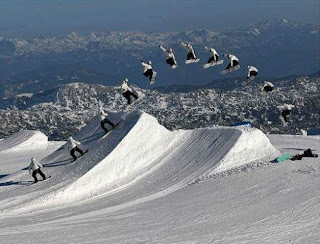Camera meters measure the light reflecting off of subjects in the frame, and use those measurements to determine the appropriate exposure settings such as shutter speed, f-stop, or ISO.
This system is universally designed to render subjects as ‘middle gray’ or ‘18% gray’.
Just to clarify what that means: Middle gray is roughly the midtone on a gray scale – appearing to fall exactly between pure black and pure white.
Subjects of this tone reflect about 18% of light (comparatively, white objects reflect nearly 100% and black objects reflect nearly 0%).
In-camera light metering works reasonably well with most subjects, in most lighting situations.
However, there are tricky scenes that will baffle most meters – and snow is a classic example.
Most cameras have more than one metering mode (though they all use the basic reflective approach described above).
Evaluative:
Metering is directly linked to, and concentrated on, the active Autofocus (AF) point.
Light values measured at the active AF point are compared with light values measured from the metering segments surrounding the active point, and the camera's metering system attempts to provide an accurate exposure based on that comparison.
This metering pattern is often effective when photographing people, but may not be quite as effective when photographing snowy landscapes depending on other elements in the scene.
Note that because Evaluative Metering is linked to active AF points,focusing on a different subject may result in a very different exposure – even within the same shot. Note: In the simulated viewfinder,Evaluative mode is shown with the left-most AF point active.
Spot:
This metering mode gets exposure information only from the single exposure zone in the center of the frame (approximately 3% of the total picture area)
Partial:
This metering mode is similar to Spot Metering, but covers a slightly larger area, reading only the cross-shaped central five metering zones (approximately 10% of the total picture area)
Center-weighted Average:
This metering mode averages the exposure for the entire picture area, but with greater emphasis on the center metering zones.
When photographing snow, If the overall scene is evenly lit and of generally even brightness, than Center-weighted Average will work well to give a good overall exposure.
Spot and Partial metering will work well with subjects that have more extreme contrast, and/or when you don’t want one part of the shot to ‘confuse’ the meter.
These modes are very useful when used in combination with the Auto Exposure (AE) Lock button found on most digital SLRs.
Unfortunately, even when the camera ‘accurately’ determines the correct exposure using the metering mode of your preference,
with a subject like snow you are likely to see underexposed results. You can compensate by adding about one or two stops of exposure through Exposure Compensation in most of the Creative Zone AE modes (more on that below),
or by using a slower shutter speed, a wider aperture, or a higher ISO speed setting in Manual exposure mode
Exposure Compensation
Exposure Compensation (EC) is an easy way to get around your camera’s tendency to underexpose bright subjects, and overexpose dark ones.
It’s also very useful for photographers who are new to Creative Zone shooting because it doesn’t require extensive knowledge of f-stops or shutter speeds.
Exposure Compensation is available in P, Tv, Av and A-DEP shooting modes only (in Manual 'M' mode,
EC is completely disabled, and you have to make all exposure adjustments yourself)

























